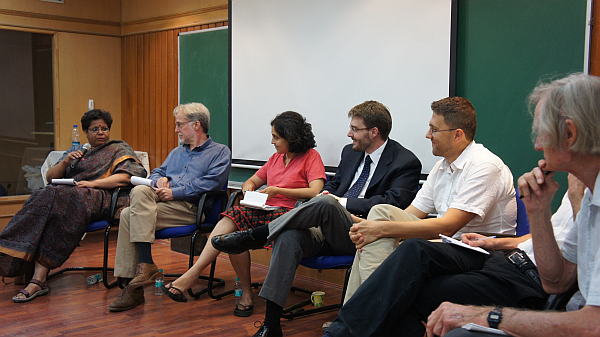Several scholars across disciplines provide converging evidence of the key role of open defecation in explaining child stunting in India. This column summarises the key themes of a recent conference at the Delhi School of Economics on child height in India.
For two days, leading scholars of child height – economists, epidemiologists, nutritionists, and pediatricians – and government officials met at the Delhi School of Economics for a conference supported by the World Bank’s Water and Sanitation Programme to share research on an urgent question: why are children in India so short? Height is an important indicator of overall health and human development because the same things that make a child grow tall are what make a child grow smart. In presentation after presentation of the conference, sanitation stood out as an important part of this puzzle. Unfortunately, India has exceptionally poor sanitation: 60% of the open defecation that happens in the world happens in India alone, and almost 50% of the Indian population report not using a latrine regularly. Not only is open defecation an immense hardship for those who have no other practical option and an important issue of human dignity, the Conference on Sanitation and Stunting also presented an overwhelming convergence in the evidence showing open defecation as a key factor explaining widespread stunting in India.

Epidemiological studies show that diseases associated with fecal pathogens increase the odds of stunting
There are very plausible biological links between exposure to fecal pathogens and diseases like diarrhea, nematode infection (also known as worms), and environmental enteropathy (a disease of the small intestine that prevents nutrients from being absorbed by the body), and studies by Checkley et al and Humphrey have shown that these diseases increase the odds of stunting. A recent meta-analysis, which summarises the results of all of the high-quality research available on water, sanitation, and hygiene interventions, provides suggestive evidence that water quality interventions are effective in reducing stunting (Dangour et al 2013).
Nutritional studies demonstrate important interactions between open defecation and nutritional intake for child height
Nutritionists at the conference also explored the role of nutrition in child stunting, and their studies showed that nutrition alone cannot explain stunting. A recent Lancet series on nutrition included an analysis showing that in the 34 countries that encompass more than 90% of the stunting burden, if the 10 most effective nutrition interventions were scaled up to cover 90% of the population, we would see only a 20% reduction in stunting (Bhutta et al 2013). Maternal and child nutrition are certainly very important for child health, but the research has shown that the combined impact of nutritional interventions and proper sanitation is more effective than either one individually.
Two completed Randomised-controlled trials show a causal effect of sanitation on stunting, others are underway
Randomised-controlled trials (RCT) are useful because they randomly assign treatment, and thus overcome many of the selection biases that plague other types of studies. Two RCTs of sanitation interventions, in Maharashtra (Hammer and Spears 2013) and Indonesia (Cameron et al 2013), show causal evidence of the effect of improved sanitation on increasing child height. Three other RCTs are underway in Orissa, Bangladesh, and Zimbabwe, two of which innovatively examine the effect of sanitation on environmental enteropathy by examining urine and blood samples.
International comparisons and within country comparisons over time can explain lots of variation in child height and haemoglobin levels using open defecation alone
Attendees of the conference also heard about studies looking at the link between sanitation and child health outcomes across countries. An international comparison by Spears shows that countries where many people defecate openly are the same countries where the most children are stunted and the average child is shortest (Spears 2012). In fact, cross-country differences in sanitation explain 54% of the international variation in average child height. Another international comparison shows that countries where many people defecate openly are the same countries where children have the lowest haemoglobin levels, on average. Haemoglobin is an important measure of health because it is a marker of anaemia. Biologically, many factors may affect haemoglobin levels, and diarrhea, nematode infections, and environmental enteropathy are some of them. Two other studies look at Bangladesh and Cambodia in particular and find that the regions where sanitation improved the most over time were the same regions where child height improved the most over time. The effects of open defecation in these studies do not go away when other variables that may plausibly mediate the relationship are accounted for. While one cannot infer causality from these non-experimental studies, they are notably consistent with the findings from the experimental, epidemiological, and nutritional literatures1.
The size of the effect of sanitation on stunting is similar across several independent studies
The diverse array of research that was presented over the two days of the conference was very consistent both qualitatively and quantitatively. The sum total of the evidence discussed suggests that sanitation is very important for child height, and therefore for future achievement. Moreover, several different independent studies show remarkably similar estimates of effect sizes. The evidence from Cambodia and Bangladesh report effect sizes for sanitation that are just about what would be required for sanitation to explain the entire India-Africa height gap, and the evidence from Maharashtra reports one that is larger. Of course, there will still be much room for improvement after getting Indian children to the height of African children.
Research should now explore how to get people to use latrines, and how to design incentives so government officials prioritise sanitation
Since it is now clear from all the research presented in the conference that sanitation is very important for child height, research should now move on to looking into how to do something about it. Why have Cambodia and Bangladesh been able to achieve such huge reductions in open defecation in recent years, and can the same things be done in India? What are the cultural norms surrounding sanitation practices in India? Why do many of the latrines built by the Total Sanitation Campaign remain unused? What kinds of policies would stimulate behavioural change and bring about a reduction in open defecation? On the supply-side, how can we design incentives to improve construction quality and reduce the siphoning of funds? These are the kinds of questions that the research community should now be focusing on.
Notes:
- The study explaining variation in haemoglobin, and the studies on Bangladesh and Cambodia are as yet not publicly available. Slides from the three presentations can be found here: http://riceinstitute.org/wordpress/conference-on-height-and-sanitation
Further Reading
- Checkley, William, Gillian Buckley, Robert H. Gilman, Ana M.O. Assis, Richard L. Guerrant, Saul S. Morris, Kåre Mølbak, Palle Valentiner-Branth, Claudio F. Lanata, Robert E. Black, and The Childhood Malnutrition and Infection Network (2008), “Multi-country analysis of the effects of diarrhoea on childhood stunting,” International Journal of Epidemiology, 37(4): 816–830. http://www.ncbi.nlm.nih.gov/pmc/articles/PMC2734063/
- Humphrey, Jean H. (2009), “Child undernutrition, tropical enteropathy, toilets, and handwashing,” The Lancet, 374: 1032–35. http://d.yimg.com/kq/groups/13947767/662678642/name/Lancet+Zwitambo.pdf
- Dangour, Alan D., Louise Watson, Oliver Cumming, Sophie Boisson, Yan Che, Yael Velleman, Sue Cavill, Elizabeth Allen, and Ricardo Uauy (2013), “Interventions to improve water quality and supply, sanitation and hygiene practices, and their effects on the nutritional status of children,” Cochrane Database of Systematic Reviews, Issue 8. http://onlinelibrary.wiley.com/doi/10.1002/14651858.CD009382.pub2/full
- Bhutta, Zulfiqar A., Jai K. Das, Arjumand Rizvi, Michelle F. Gaffey, Neff Walker, Susan Horton, Patrick Webb, Anna Lartey, Robert E. Black (2013), “Evidence-based interventions for improvement of maternal and child nutrition: what can be done and at what cost?” The Lancet, 382: 452-477. http://www.thelancet.com/journals/lancet/article/PIIS0140-6736(13)60996-4/fulltext
- Hammer, Jeff, and Dean Spears (2013), “Village sanitation externalities and children’s human capital: Evidence from a randomized experiment by the Maharashtra government.” http://www.princeton.edu/rpds/papers/Village_Sanitation_Externalities_February2013.pdf
- Cameron, Lisa, Manisha Shah, and Susan Olivia (2013), “Impact Evaluation of a Large-Scale Rural Sanitation Project in Indonesia,” Policy Research Working Paper Series, Number 6360, World Bank. http://elibrary.worldbank.org/content/workingpaper/10.1596/1813-9450-6360
- Spears, Dean (2012), “How much international variation in child height can sanitation explain?” http://riceinstitute.org/wordpress/research/?did=13




 19 August, 2013
19 August, 2013 




Comments will be held for moderation. Your contact information will not be made public.